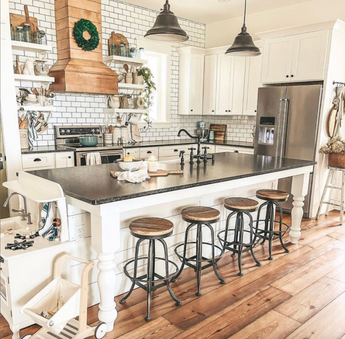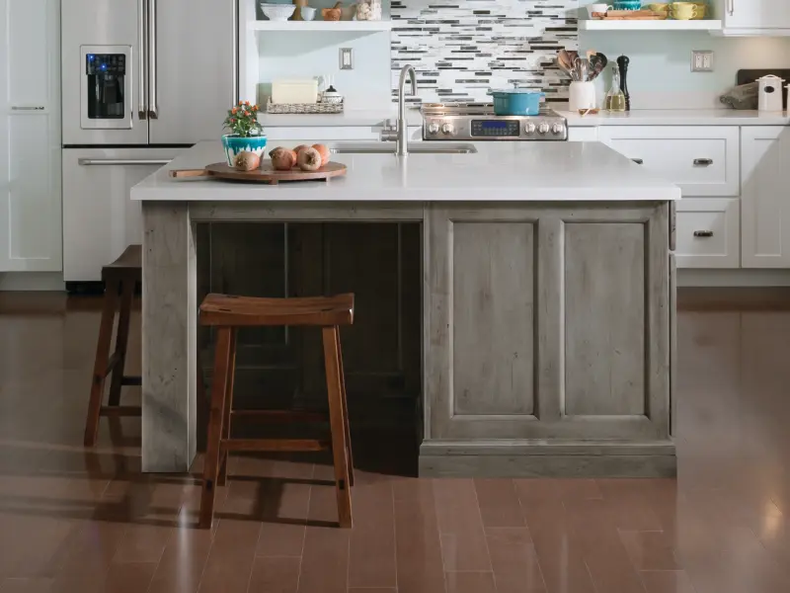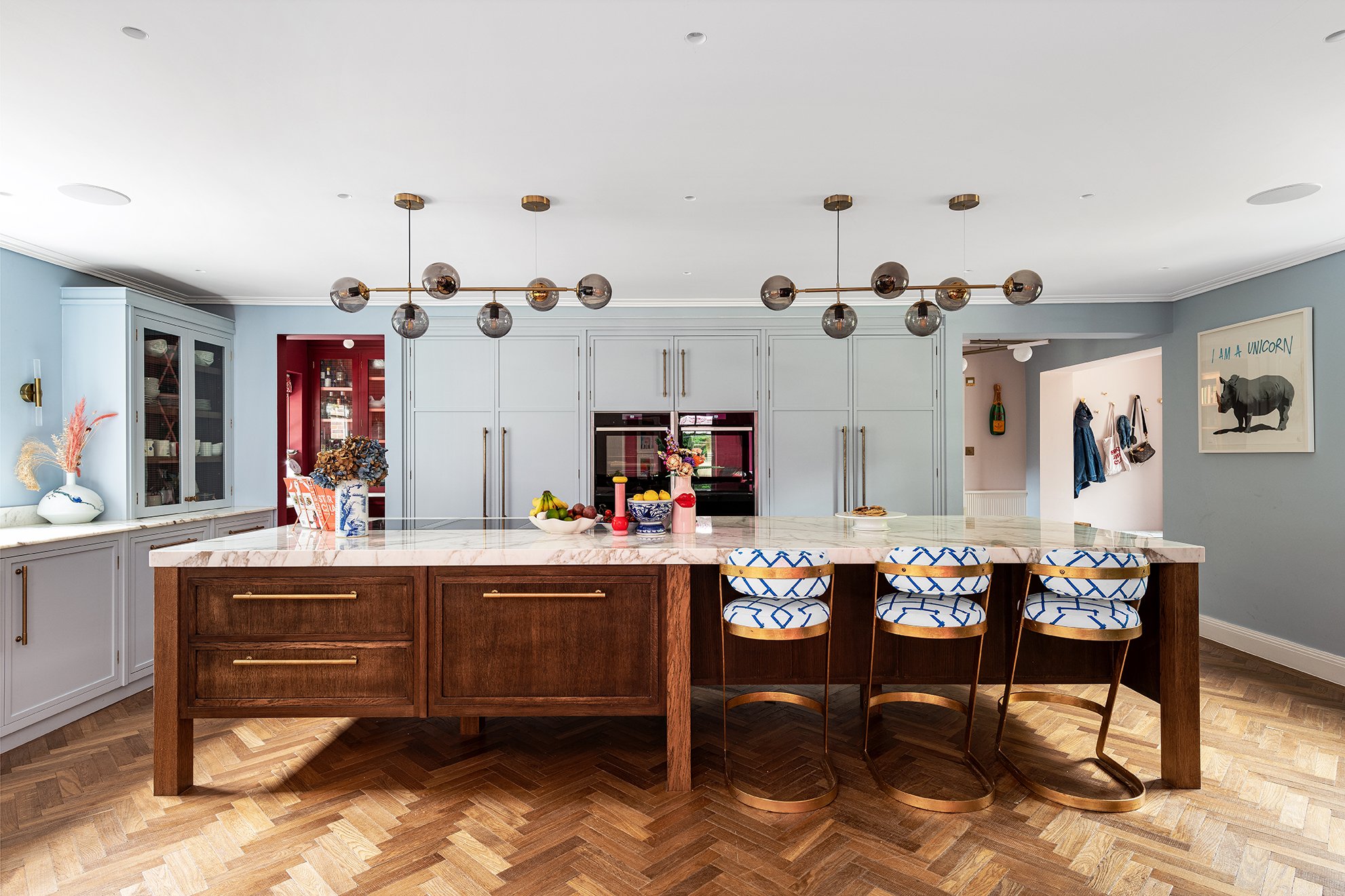Personalized Kitchen Island Legs to Suit Your Kitchen Visual
Personalized Kitchen Island Legs to Suit Your Kitchen Visual
Blog Article
An Overview to Choosing the Suitable Kitchen Island for Your Home
Recognizing your kitchen area's spatial characteristics is the initial step, making sure that the island fits perfectly without interrupting the circulation. The choice of surfaces and products additionally plays a crucial duty in harmonizing the island with your kitchen area's general layout.
Analyzing Your Space
Before selecting a kitchen island, it is necessary to extensively examine your room to guarantee the enhancement will certainly be both functional and cosmetically pleasing. Begin by measuring the offered area, consisting of the width, length, and elevation of the cooking area. Exact dimensions are crucial to prevent buying an island that overwhelms the room or one that is disproportionately small.
Think about the existing layout and how the island will certainly integrate with the current traffic circulation. A well-placed island ought to not obstruct paths or hinder accessibility to necessary home appliances, such as the fridge, sink, and stove. Leave ample clearance area-- usually around 36 to 48 inches on all sides-- to allow for comfy movement and work area efficiency.
Following, evaluate the natural light and sightlines within your kitchen area. An island that blocks a home window or interferes with visual cohesion can make the area really feel cramped and dark. Consider how the island's positioning will impact lighting and exposure, guaranteeing it improves instead of interferes with the kitchen area's setting.
Figuring Out the Objective
Identifying the objective of your kitchen island is an important step in guaranteeing it meets your specific requirements and preferences. Prior to delving into style or size factors to consider, it is necessary to clarify what primary feature the island will certainly offer in your cooking area. Will it be a main hub for meal prep work, a laid-back dining area, or potentially an added storage solution?
Additionally, enough counter room for slicing and blending, along with easily accessible storage space for kitchen area tools and components, can change the island into an efficient workstation. Conversely, if the island is intended to promote social communications or serve as a dining area, seating setups come to be vital.

Picking the Right Dimension
Picking the appropriate dimension for your kitchen island is a balance of performance and area optimization. An ideal kitchen island should provide sufficient office while making certain that activity around the kitchen area stays unobstructed. Begin by gauging your cooking area space; a minimal clearance of 36 to 42 inches around the island is required to enable for comfortable movement and ease of access.
The dimensions of the island ought to show its designated use. For instance, if the island will certainly serve primarily as a prep location, a size of 24 to 36 inches may be enough. However, if it is to accommodate seating, you ought to consider a bigger dimension, generally gauging a minimum of 48 inches in size. Islands dedicated to devices imp source or sinks may need additional area to house these features properly.

Finally, make certain that the island's size matches the total kitchen area design, preventing any type of frustrating visibility that could interfere with the cooking area's visual and energy - kitchen island legs. Cautious planning and exact dimensions will certainly aid you achieve a effective and unified cooking area setting
Finding Products and Finishes
After determining the ideal dimension for your cooking area island, the following action involves selecting suitable products and coatings. The choice of materials significantly affects both the visual appeal and performance of your cooking area island. Popular materials for counter tops consist of granite, quartz, and butcher block, each offering unique benefits. Granite, known for its toughness and timeless sophistication, is highly immune to scratches and warmth. Quartz, a crafted stone, gives a non-porous surface area that resists germs and stains. Butcher block, made from hardwood, adds a warm, rustic appeal and is perfect for food prep work.
Along with the countertop, consider the materials for the space station. Strong timber provides a traditional, durable appearance, while stainless-steel offers a sleek, modern appearance and is easy to clean. Painted surfaces can present a sprinkle of shade, with choices ranging from muted pastels to vibrant, lively shades.
When selecting finishes, guarantee they match the overall kitchen layout. Matte finishes offer a modern feel, while glossy surfaces can create a polished, high-end appearance. Take note of the resilience of finishes, specifically in high-traffic locations, to maintain the island's look over time. Selecting check the ideal materials and coatings will boost both the capability and visual allure of your cooking area island.
Integrating Functional Functions
Including functional attributes into your kitchen area island can considerably enhance its energy and convenience, changing it right into a flexible focal point of your kitchen. One vital attribute to think about is added storage. Integrating cupboards, cabinets, and open shelving can give much-needed space for cookware, utensils, and little appliances, helping to keep a clutter-free environment.
One more useful addition is an integrated sink or cooktop, which can improve dish preparation and clean-up processes. A sink can facilitate tasks such as washing veggies and cleaning up recipes, while a cooktop can allow for food preparation directly on the island, fostering a more social and interactive cooking experience.
Take into consideration integrating seating choices, especially if your cooking area functions as an informal eating area. Bar stools or built-in benches can transform the island into a multifunctional room for meals, research, or laid-back gatherings.
Finally, incorporating electric outlets into your kitchen area island can improve its practicality. Electrical outlets give hassle-free access for tiny cooking area devices, billing terminals for digital tools, and added lights options.
Conclusion

Before choosing a cooking area island, it is crucial to completely examine your room to ensure the addition will certainly be both functional and visually pleasing.Selecting the appropriate dimension for your kitchen area island is an equilibrium of performance and area optimization. kitchen island legs. An optimal cooking area island need to supply ample workspace while guaranteeing that activity around the kitchen remains unobstructed.Integrating functional features right into your kitchen island can dramatically enhance its utility and comfort, transforming it right into a flexible centerpiece of your kitchen area.In conclusion, choosing the perfect cooking area island requires a detailed analysis of the offered space, clearness regarding its key feature, and careful consideration of the ideal size and materials
Report this page